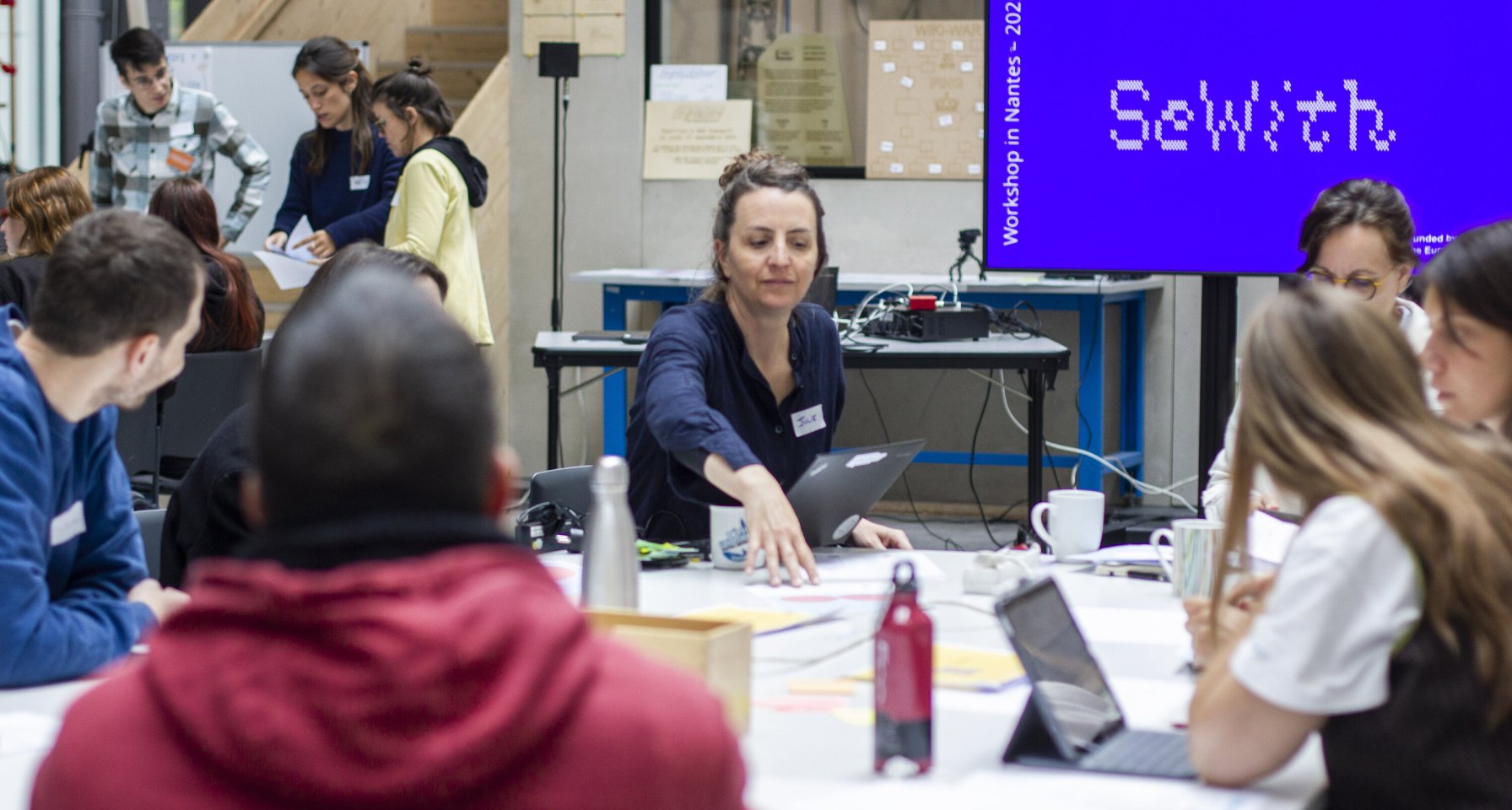ENGLISH VERSION BELOW
Dans le cadre du projet européen SeWith, nous organisons en 2025 une série d'échanges avec nos partenaires italiens d'OpenDot pour en apprendre plus sur leur méthodologie du co-design et pour l'expérimenter ensemble par le biais de workshops au sujet de l'habillement pour les personnes en situation de handicap. Après une première visite à Milan en janvier, nous avons organisé un workshop à Nantes la semaine du 12 mai avec le Humanlab de l'APAJH 44 et le fablab milanais OpenDot
L'objectif du workshop
L'objectif principal de notre workshop était d'expérimenter et d'appliquer les méthodes du co-design pour développer des vêtements adaptés pour des personnes en situation de handicap, en impliquant à la fois les personnes concernées par le besoin, des designers·euses textiles français·e et italien·nes et des volontaires des deux organisations françaises.
Par là, l'idée principale était de (se) former par le faire à la méthode du co-design l'ensemble des participant·es (personnes en situation de handicap, salarié·es, bénévoles et designers·euses). Pour nous un des objectifs sous-jacent était aussi de mieux appréhender cette méthode afin de pouvoir développer une formation professionnelle sur le sujet dans les années à venir.
Préparation du workshop
En amont du workshop, nous avons publié un appel à besoins à destination des personnes en situation de handicap sur nos sites internet et nos réseaux sociaux, mais aussi de façon plus ciblée au travers des réseaux de l'APAJH 44 et d'autres structures partenaires. Cela nous a permis d'identifier quatre besoins et cas d'études intéressants pour le workshop. Nous avons aussi partagé un appel à participation aux designers, designers textiles, et volontaires intéressés.
En partant de l'expérience d'OpenDot de ce type de formats, nous avons aussi travaillé conjointement avec nos partenaires sur le déroulé du workshop. Comme le processus de co-design peut nécessiter du temps, nous avons décidé de scinder en deux ce processus : notre workshop du mois de mai à Nantes était donc consacré à la première partie, du besoin au concept. La seconde partie du processus, du concept au développement de prototypes, fera l'objet d'un deuxième workshop, à Milan, en octobre 2025.
Pour notre premier workshop, le programme était donc le suivant :
- Jour 1 :
- Visite et découverte du fablab d'Hyperlien
- Rencontre entre participant·es
- Jour 2 :
- Présentation d'outils du co-design (manifesto, interview, brief)
- Conférence autour des sujets du vêtement et du handicap par Linda Zamboni
- Travaux de groupes sur les outils d'interview et de brief
- Jour 3 :
- Travaux de groupes sur des concepts de vêtements adaptés ou d'aides techniques à l'habillement
- Restitution publique
- Jour 4 :
- Débrief des jours précédents
- Préparation du second workshop à Milan
Constitution des groupes
Pour l'ensemble des travaux de groupes, l'idée était que les participant·es travaillent sur les problématiques identifiées lors de l'appel à besoins. Pour un effectif total de 25 personnes, divisé en quatre groupes, chaque groupe devait comprendre au moins une personne familiarisée avec la méthode du co-design, ainsi que la personne en situation de handicap qui avait formulé le besoin étudié. Comme plusieurs participantes venaient d'Italie et d'autres de la même école de mode (l'Atelier Chardon Savard), nous avons aussi souhaité favoriser l’interconnaissance et l'interculturalité en leur demandant si possible de se répartir dans des groupes différents.
Déroulement du workshop
Après un premier jour de découverte des lieux pour nos invité·es d'Italie et de rencontre entre participant·es, le workshop a vraiment débuté le deuxième jour avec une introduction à la méthode du co-design et à ses principaux outils.
Ce sont donc Marta et Emma, de l'équipe d'OpenDot, qui nous ont présenté le manifeste du co-design, et les outils d'interview pour la collecte des besoins et de rédaction d'un brief, avec des exemples tirés de projets d'aides techniques menés par leurs équipes avec des personnes en situation de handicap.
Lien vers le co-design toolkit
Ensuite, Linda Zamboni designeuse textile et enseignante à l'Istituto Marangoni Firenze nous a proposé une présentation au sujet du design textile et des enjeux liés au handicap.
L'après-midi de ce deuxième jour a été consacrée à un premier temps de travaux de groupes, autour des outils d'interview et de brief. L'objectif était de mener l'enquête sur les besoins exprimés par les personnes concernées présentes, avant de définir et de cadrer collectivement un brief à partir duquel travailler sur la suite du workshop.
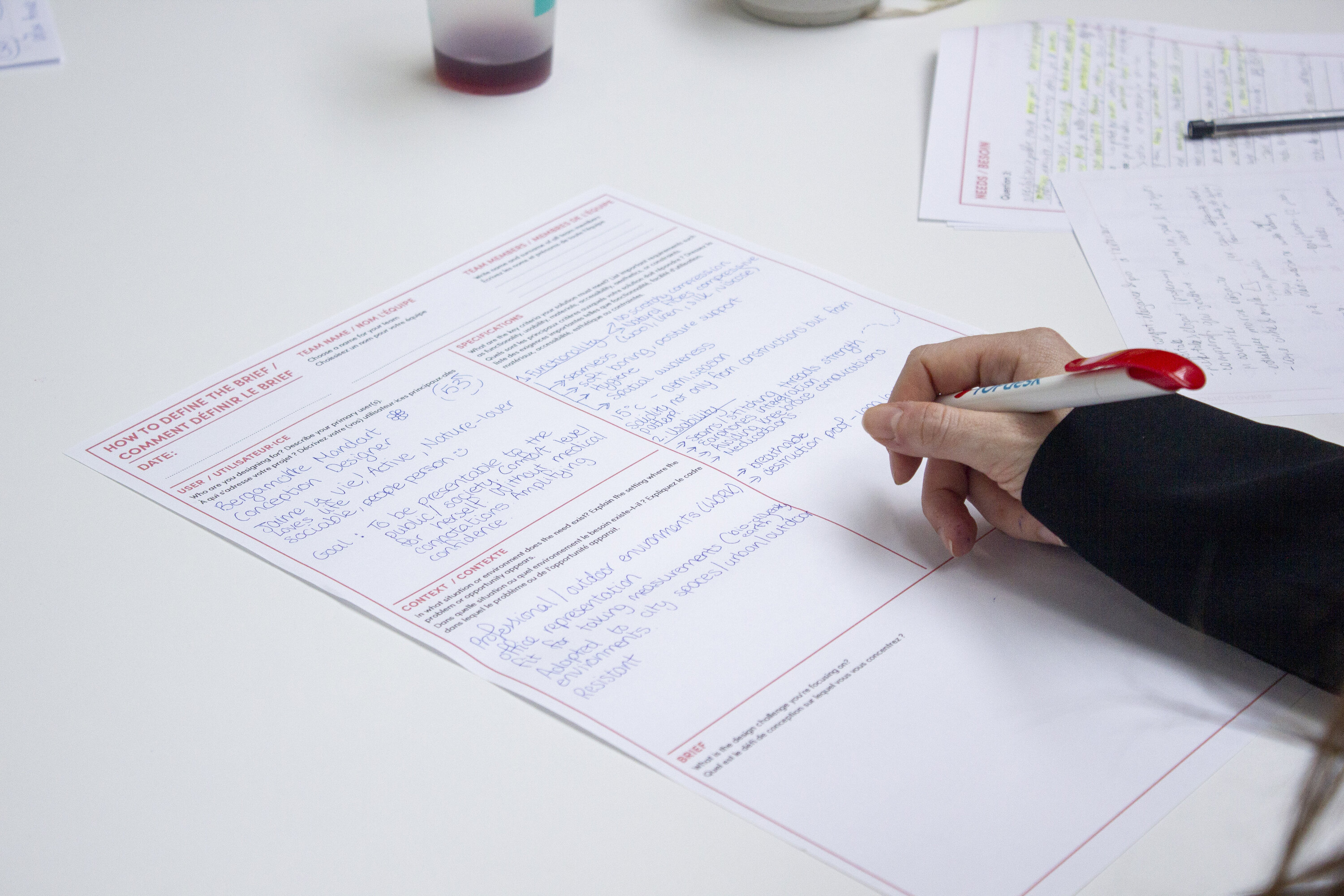
Le troisième jour a été consacré à l'exposition et à l'expérimentation de pratiques liées à la méthode de co-design avec une phase de collecte d'inspirations, une phase d'idéation avec des moodboards, et une phase de création de concepts.
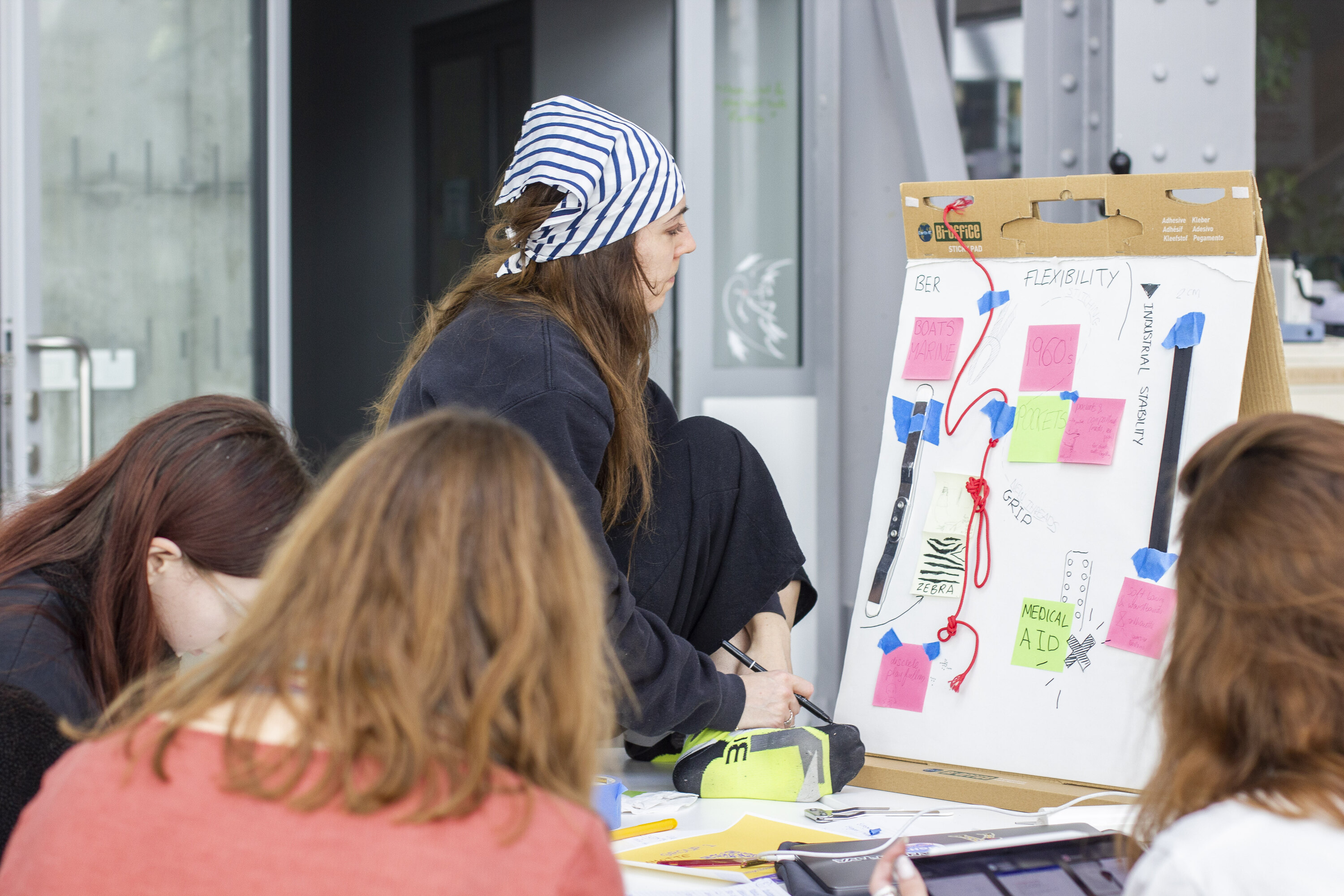
Des temps de travaux de groupes ont permis de faire émerger de premiers prototypes par itérations et dans l'échange avec les personnes en situation de handicap impliquées.
Après une journée riche d'émulation collective, nous avons terminé par une restitution ouverte au public et un moment convivial autour d'un apéro.
Enfin, le quatrième jour a été consacré au débrief du workshop, duquel nous avons retiré quelques enseignements, exposés plus loin dans l'article.
Les réalisations
Tout au long du workshop, nos différents groupes ont travaillé autour de quatre sujets :
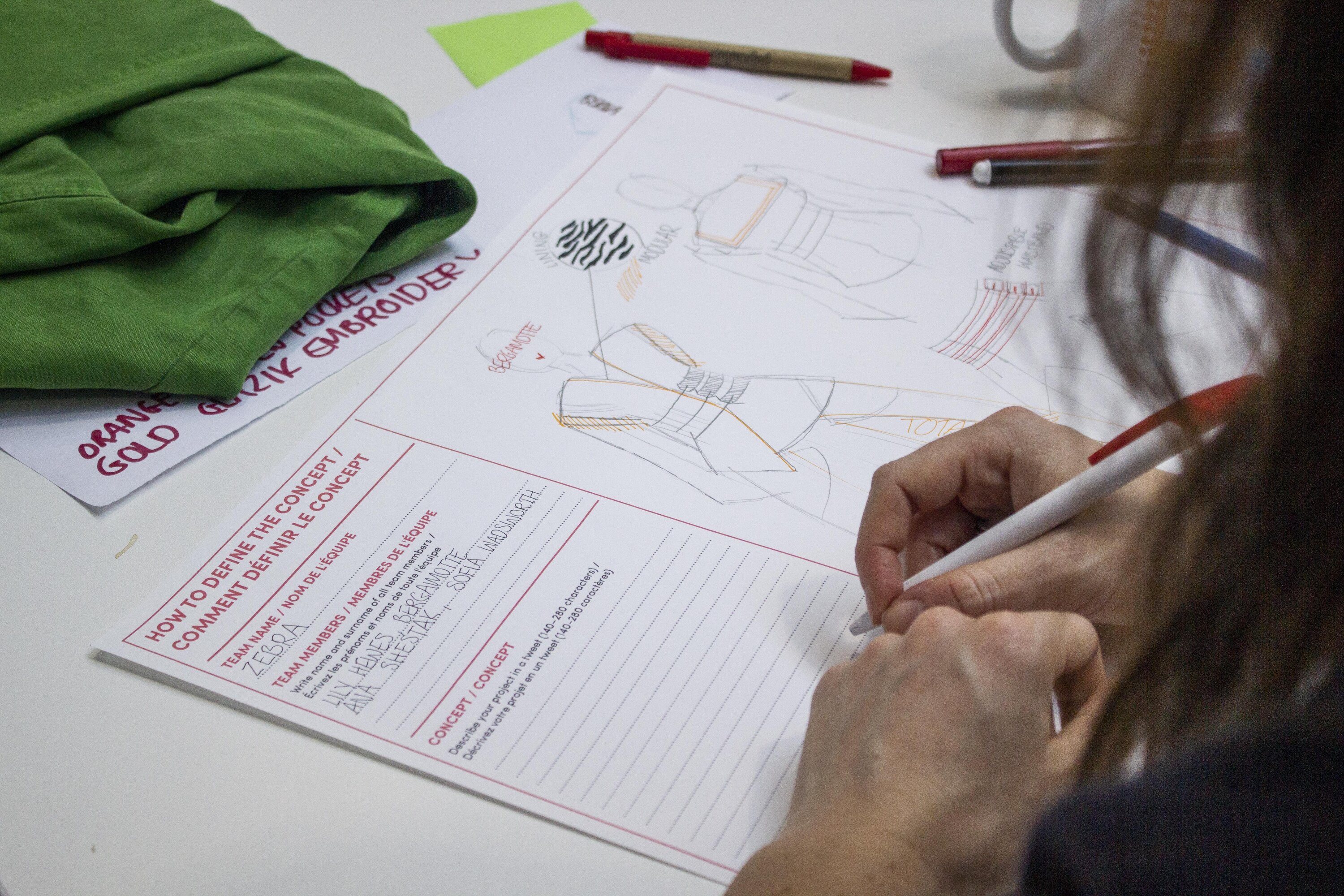
1) Une tenue et accessoires pour une femme qui a le syndrome d'Ehlers-Danlos et un trouble du spectre de l'autisme, ce qui pose des contraintes matérielles et sensorielles. Le produit sera adapté à son lifestyle, sa santé et ses goûts esthétiques.
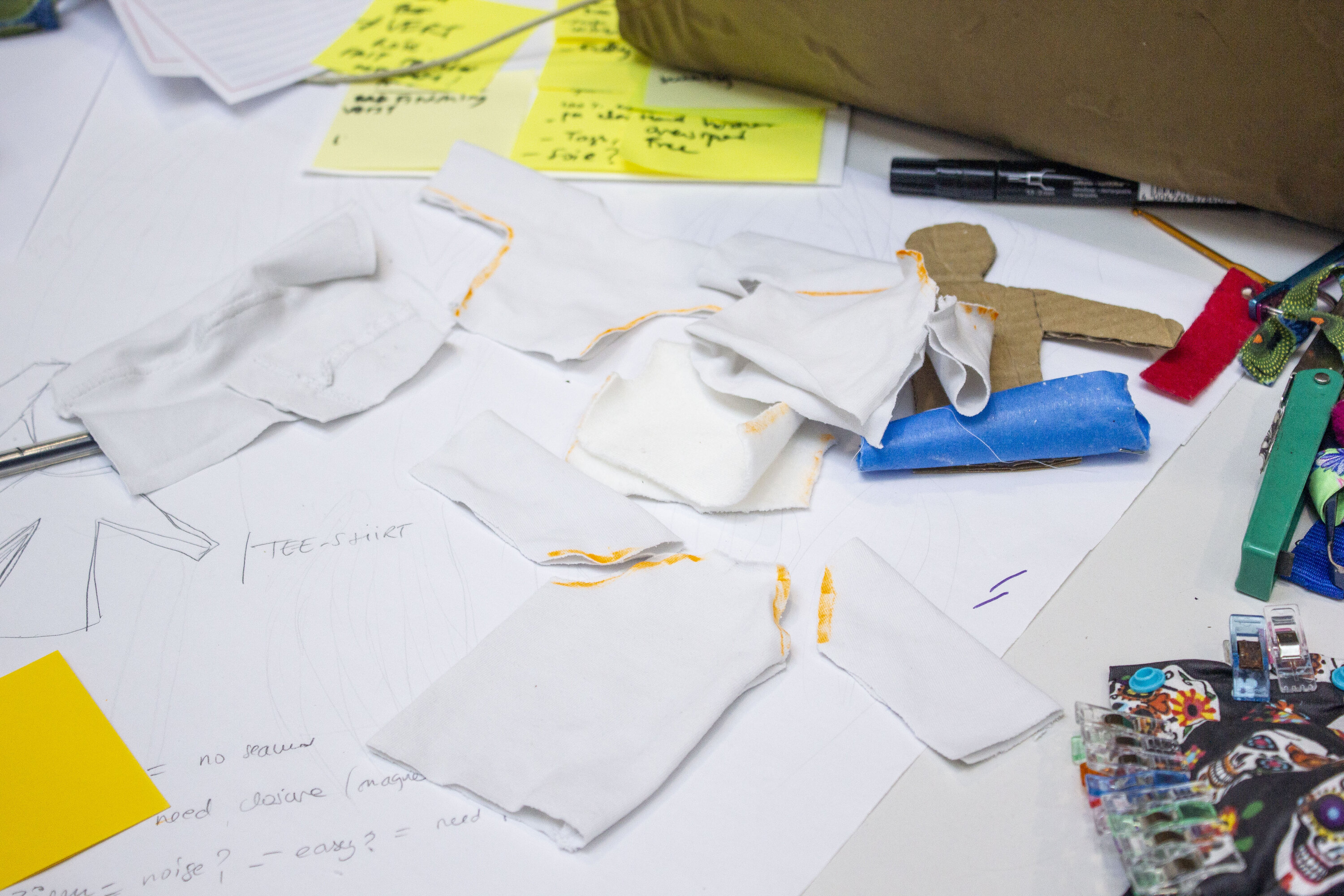
2) Un haut adapté à un homme avec un trouble du spectre de l'autisme, qui réduise l'inconfort lié à certaines particularités sensorielles. Comme une seconde peau, le vêtement est une protection fabriquée sans coutures apparentes, afin de ne pas nuire à une peau sensible. Le tissu doit être hypoallergénique et la façon dont le vêtement est mis sur le corps nécessite également une ouverture spéciale.
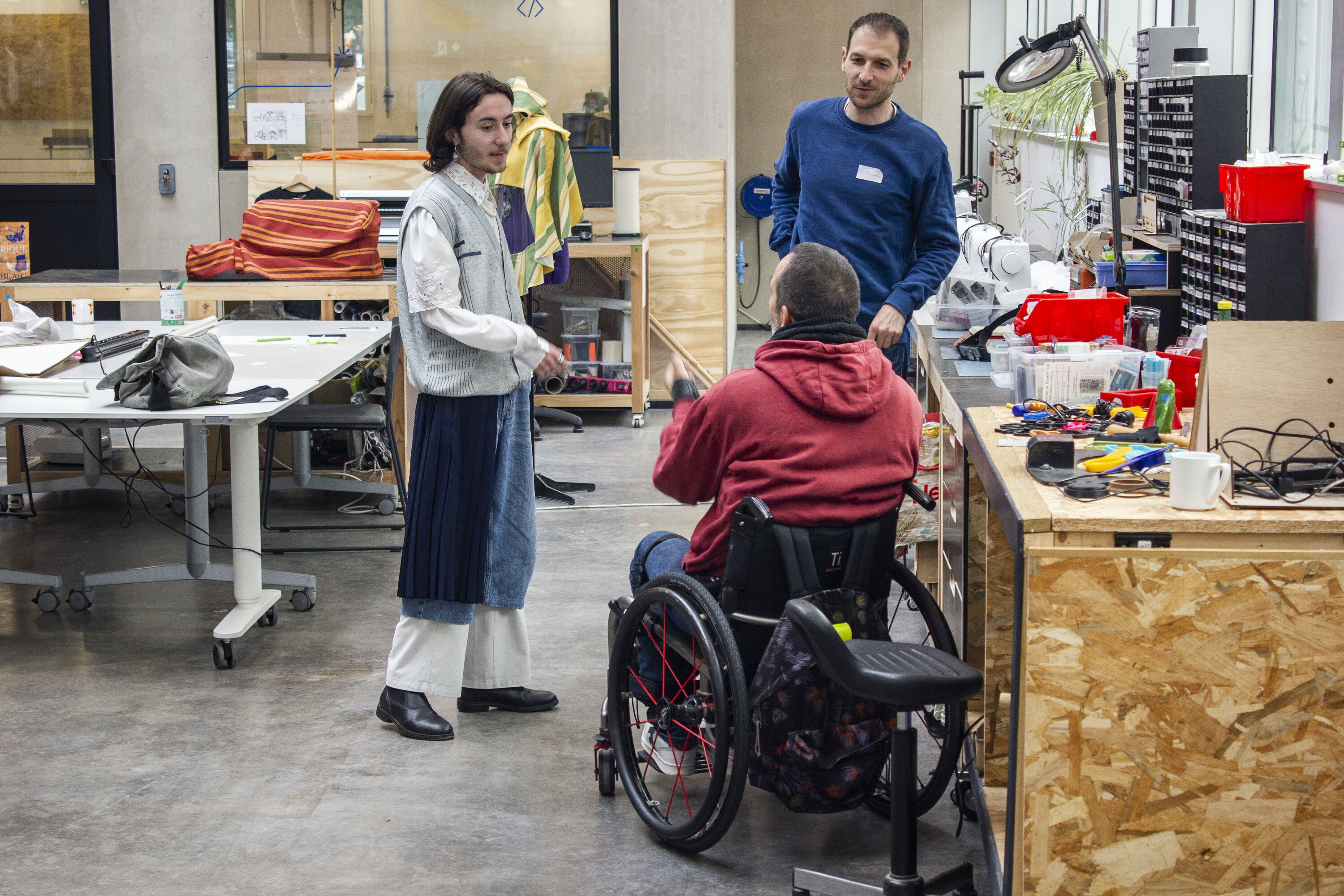
3) Une aide technique liée à l'habillement d'un homme tétraplégique. Pour faciliter l'enfilage de sweat à manches longues sans que les manches d'un sous-pull remontent le long des bras dessous. Cette personne souhaite idéalement porter des vêtements classiques "non adaptés spécifiquement" et préfère une aide technique à une modification intégrée aux vêtements.
4) Une aide technique liée à l'habillement d'un homme tétraplégique, qui lui permette de descendre plus facilement un vêtement dans le bas du dos, tout en étant assis sur un fauteuil roulant.
À partir de ces quatre sujets, sept prototypes ont été réalisés et seront poursuivis lors du second workshop à Milan. Ils seront ensuite documentés, afin de pouvoir être répliqués ou détournés par d'autres personnes ayant des besoins similaires ou approchants.
Exemples de planches concepts


Nos points d'attention pour l'organisation d’événements similaires
Au travers de ce workshop, nous avons relevé quelques points d'attention quant à l'organisation d'événements de ce type :
- Il est vraiment important lors des travaux de groupe qu'il y ait toujours à minima une personne avec de l'expérience de la méthode de co-design dans chaque groupe afin de pouvoir guider débloquer les questionnements méthodologiques.
- Dans le cas où l'un·e des participant·es les plus concernés a un empêchement le jour J ou sur une partie du workshop : il peut être intéressant d'avoir collecté en amont des matériaux (des éléments sur la problématique, un pré-entretien etc.) pour pouvoir commencer le travail même si les groupe ne sont pas complets.
- Dans le cas de groupes mixtes en termes de langue : prendre soin de la facilitation et de la traduction avec une à plusieurs personnes bilingues dans chaque groupe.
- Faire confiance au processus : en général, les participant·es ont tendance inconsciemment à vouloir sauter les étapes préliminaires de collecte des besoins et de brief pour sauter directement dans des phases d'idéation, prototypage. Pourtant, le soin accordé à l'écoute de la personne et à l'exposition et à la synthèse de son besoin est absolument cruciale.
Merci encore à l'ensemble des participant·es et à tous nos partenaires pour ce très beau moment de partage et d'expérimentations. Nous avons déjà hâte de poursuivre ces travaux en octobre !
As part of the European project SeWith, in 2025 we are organising a series of exchanges with our Italian partners from OpenDot to learn more about their co-design methodology and to experiment with it together through workshops on the subject of clothing for people with disabilities. After an initial visit to Milan in January, we organised a workshop in Nantes during the week of 12 May with the Humanlab of APAJH 44 and the Milanese fablab OpenDot.
The aim of the workshop
The main aim of our workshop was to experiment with and apply co-design methods to develop adapted clothing for people with disabilities, involving the people concerned by the need, French and Italian textile designers and volunteers from the two French organisations.
The main idea was to train all the participants (people with disabilities, employees, volunteers and designers) in the co-design method. For us, one of the underlying objectives was also to gain a better understanding of this method so as to be able to develop professional training on the subject in the years to come.
Preparing for the workshop
Ahead of the workshop, we published a call for needs aimed at people with disabilities on our websites and social networks, but also in a more targeted way through the networks of APAJH 44 and other partner organisations. This enabled us to identify four interesting needs and case studies for the workshop. We also issued a call for participation to interested designers, textile designers and volunteers.
Drawing on OpenDot's experience of this type of format, we also worked with our partners on the workshop schedule. As co-design can be a time-consuming process, we decided to divide it into two parts: our May workshop in Nantes was devoted to the first part, from need to concept. The second part of the process, from concept to prototype development, will be the subject of a second workshop in Milan in October 2025.
The programme for our first workshop was as follows:
- Day 1:
- Visit and discovery of the fablab Hyperlien
- Meeting between participants
- Day 2:
- Presentation of co-design tools (manifesto, interview, brief)
- Conference on clothing and adaptive design by Linda Zamboni
- Group work on interview and brief tools
- Day 3:
- Group work on concepts for adapted clothing or technical aids for clothing.
- Public feedback
- Day 4:
- Debriefing of previous days
- Preparation for the second workshop in Milan
Setting up the groups
For all the group work, the idea was for the participants to work on the issues identified in the call for needs. For a total of 25 people, divided into four groups, each group had to include at least one person familiar with the co-design method, as well as the person with a disability who had formulated the need studied. As several of the participants came from Italy, we also wanted to encourage inter-knowledge and interculturality by asking them to split up into different groups if possible.
How the workshop went
After a first day of getting to know the venue for our guests from Italy and meeting other participants, the workshop really got underway on the second day with an introduction to the co-design method and its main tools.
Marta and Emma, from the OpenDot team, introduced us to the co-design manifesto, and the tools for interviewing needs and writing a brief, with examples taken from technical aids projects carried out by their teams with people with disabilities.
Linda Zamboni, textile designer and lecturer at Istituto Marangoni Firenze, then gave a presentation on adaptive textile design and disability issues.
The afternoon of the second day was devoted to initial group work, using interview and brief tools. The aim was to conduct a survey of the needs expressed by the people concerned, before defining and framing a collective brief from which to work on the rest of the workshop.

The third day was devoted to exhibiting and experimenting with practices linked to the co-design method, with an inspiration-gathering phase, an ideation phase using moodboards, and a concept creation phase.

Group work enabled the first prototypes to emerge through iterations and exchanges with the disabled people involved.
After a day rich in collective emulation, we ended with a report open to the public and a convivial moment over an aperitif.
Finally, the fourth day was devoted to debriefing the workshop, from which we drew a number of lessons, set out later in the article.
Achievements
Throughout the workshop, our different groups worked on four subjects:

1) An outfit and accessories for a woman with Ehlers-Danlos syndrome and an autism spectrum disorder, which poses material and sensory constraints. The product will be adapted to her lifestyle, health and aesthetic tastes.

2) A top designed for a man with an autism spectrum disorder, to reduce the discomfort associated with certain sensory characteristics. Like a second skin, the garment is made without visible seams, so as not to harm sensitive skin. The fabric must be hypoallergenic, and the way the garment is put on the body also requires a special opening.

3) A technical aid for dressing a quadriplegic man. To make it easier to put on long-sleeved sweatshirts without the sleeves of an undershirt running up his arms. Ideally, this person would like to wear conventional clothing that has not been "specifically adapted", and prefers a technical aid to a modification integrated into the clothing.
4) A technical aid linked to the clothing of a tetraplegic man, which would make it easier for him to lower a garment down his back, while sitting in a wheelchair.
Based on these four subjects, seven prototypes have been produced and will be further developed during the second workshop in Milan. They will then be documented, so that they can be replicated or adapted by other people with similar needs.
Concepts boards examples


Things to consider when organizing similar events
During this workshop, we identified a number of points to bear in mind when organising events of this type :
- It's really important during group work that there should always be at least one person with experience of the co-design method in each group, to be able to guide them through the methodological issues.
- If one of the most concerned participants is unable to attend on the day or for part of the workshop: it may be useful to have collected material beforehand (elements on the problem, a pre-interview, etc.) so that the work can begin even if the groups are not complete.
- In the case of mixed language groups: take care of facilitation and translation with one or more bilingual people in each group.
- Trust the process: in general, participants have an unconscious tendency to skip the preliminary stages of needs gathering and defining a precise brief and jump straight into the ideation and prototyping phases. However, the care taken in listening to the person and in explaining and summarising their needs is absolutely crucial.
Thank you once again to all the participants and our partners for this wonderful opportunity to share and experiment. We're already looking forward to continuing this work in October !
FUNDED BY / FINANCÉ PAR


Ce contenu est mis à disposition selon les termes de la Licence Creative Commons - Attribution - Pas d’Utilisation Commerciale - Partage dans les Mêmes Conditions 4.0 - International.

